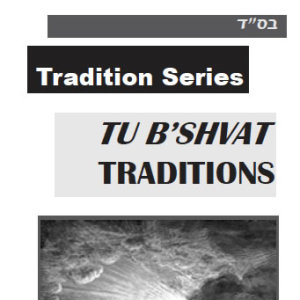Tu B’Shvat Seder Traditions
View the printable (PDF) version
Man is compared to the trees–divine logic can be observed from Scripture. “Man is as a tree of the field”. (Deut. 20:19) On Tu B’Shvat, the primary goal, as discussed in the traditional sources, is to rectify the original sin that occurred through Adam the First. It is mentioned in Jewish literature throughout the ages, that Adam’s sin was not so much in partaking of the fruit of the tree revealing good and evil, but that he did so prematurely –before his prayer to do so had been accepted from on high.
During the month of Shvat trees begin to grow exceptionally well. Most of the seasonal rains have fallen, but growth has still mostly not yet occurred. The full moon on this middle day of the month (the Jewish months are essentially lunar), is also quite relevant. Shvat is considered to correspond with the ‘delei’–the bucket of the water bearer, commonly known also as the astrological sign of Aquarius, and corresponds similarly with the tribe of Asher, who was especially blessed through the olive and other trees.
Several different arrangements to the Tu B’Shvat seder have evolved. The ‘seder’ following the customs of the ‘Pri Eitz Hadar’ was originally popular, but this arrangement of the seder is attributed to Nosan of Gaza; considered the viceroy of the premature and false messianic movement of Shabbtai Tzvi of the sixteenth century; and thus, many refrain from following the original Pri Eitz Hadar arrangement.
Various Askenazic and Sefardic communities have arrangements which vary from this one distinctively. There is also a Jerusalem custom for the seder.
Many traditional formal ‘sedarim’ of today arise in this manner…
Initially, specific verses from the Tanach (Jewish Scriptures) are recited, all relating to fruits and trees. Also, selections from the holy book of the Zohar that relate with the praises and blessing of fruit and of trees are also recited. Introductory selections also include a simple and themely prayer.
Subsequent is a fruit meal part of the seder; centering on eighteen varieties of fruit. The fruit meal however, is preceded by eating ‘mezonos’ cakes and cookies of wheat.
Then, fruits of the nut type are usually eaten first. If making the seder with wines, this is followed by a cup of white wine.
Fruits edible only on the outside are eaten next. Afterward, is a cup of mostly white wine, but with some red.
Then fruits which are totally edible. These are followed by a cup of wine mostly red, but with a substantial amount of white also.
After this, the seder calls for additional fruits to be eaten of all types generally, and this course is followed by a cup of red wine, but to which is also added just a minute amount of white.
At the conclusion, lupines are eaten, (or other fruits or nuts of the earth such as peanuts).
This is another customary arrangement…
Following Birchos HaMazon (the Grace-prayer following a bread meal at a family setting), the husband continues on and makes the blessing over ‘mezonos’ cake or cookies of wheat; and repeats the verse: “You shall be satisfied through the fat of wheat”. One does this as an omen and in hope of obtaining a blessing of plentiful sustenance throughout the year.
The wife recites a blessing over wine or grape juice; saying: “Your wife shall bear forth as the vine”.
The son says the blessing over olives, and the verse: “Your sons shall be as shoots of the olive tree, surrounding your table”.
Pomegranates and walnuts are eaten (first) by one’s daughters, and they say the following: “The glory of the king’s daughter lies within”. (The outsides of these fruits are both inedible–thus, ‘lying within’).
Date-honey and apple are given to the infants, as paralleling the teaching: “I raised you from under the apple tree. Honey and milk were under your tongue”.
It is also customary that chapters of the mishnah are chanted by those who learn mishnah while the fruit course is being bestowed and partaken of.
In kabbalistic teachings, four mystical realms are said to exist. Ten separate varieties of fruits exist primarily as a reflection of each of the three lower realms.
The noblest of these fruit types are those that are completely edible. These are fruit species closest to the remaining yet-higher realm or sphere known as Pure Emanation. These fruit is therefore considered to belong most to the second realm of Conception (or Creation).
There are likewise ten species of fruit in correspondence to the next lower realm–Formation. Seeds (pits) of fruits said to be of this second category are woody and inedible.
There are additionally ten varieties of fruits of the realm called Action (or Physicality)–paralleling its traits. In this group, the section of the fruit that is within is edible, while that which is on the outside is not. The thick or hard inedible shell of these fruits separates and defines between the sustaining fruit within and of the state of ‘general confusion’ existing in the greater expanse of reality beyond the shell or casing.
There is also a fourth category of tree and plant growth that bear fruit that is edible only through difficult preparation–if edible at all. These are usually bitter to an extreme, or difficult to process for other reasons for a holistically inclinded person. It is mentioned that Rabbi Chaim Vital for one, the great disciple of the holy ‘Arizal’, distanced himself from these, he being a master of the soul. For these all have relation to ‘the side of the left’.
One cannot help but notice the sages’ astute recognition long ago, of the potential ill effects of compounds derived from substances such as from these, many of which are misused in every generation–(plant-derived) substances and combinations that stimulate the body’s delicate chemistries to an extreme–these are substances which are often forbidden by law in many various countries and regions of the world. These similarly correspond to this last ‘non fruit-bearing tree’ category.
Four types of mixtures of wine accompany and delineate the courses of the traditional seder.
The four selections (white, red, and their majority mixtures) reflect the basic four seasons of the year. White is indicative of autumn. White with some red represents the winter–the red ‘warmth’ of emerging spring even in winter is somewhat perceivable. Red with some white, as traditionally used for the third cup, is of spring. Pure red is indicative of the summertime, when crops have fully matured.
The fifteen traditional fruits of Tu B’Shvat are the following…
Of Creation: figs, grapes, apples, pears, and quince.
Of Formation: dates, olives, plums, cherries, and hawthorn berries.
Of Action: pomegranates, almonds, walnuts, lupines (these are fruits of the earth, and not of perennial trees), and ‘sidrah’ (a tree nut, probably of a spicy nature).
Rabbi Chaim Vital mentions alternately that there are ten primary species of each general variety of fruit; thus thirty primary species, and each is indigenous to Israel. Additionally, he observes that each of these has many varieties. This follows the sages’ interpretation of the verse: “…and seventy dates”. (Exodus 15:27) The sages understood this to imply there were seventy varieties of dates there. So also is the case regarding other species of primary fruit–so the thirty species each include with them many additional varieties.
Also, each of these ten primary species is attributed of a particular of the ten ‘sefiros’ (the divine attributes) as are generally understood through kabbalistic and chassidic tradition.
These ten traits are first the three intellectual qualities of keser (crown of the ineffable); chochmah (wisdom), and binah (understanding). Then follow chesed (kindness); geverah (restriction or ‘holy selfishness’), tiferes (beauty–especially in light of its balancing virtue of the previous two contrasting traits). Then netzach (the enduring quality of truth), and hod (glory of truth). The trait following is yesod (the ‘foundation’ of purity–especially as an extension of personal lifestyle). Finally, there is malchus (the sovereignty of physciality within G-d, and spontaneous service of Him). The ten traits parallel the ten sayings of G-d during Creation; and within the Ten Commandments, as well as are of course innate within other facets of reality and of Torah thought.
As thirty, the primary fruits are the following…
Of Creation: grapes, figs, apples, esrogim (citron), sweet lemon, pears, quice, mulberries, sorb-apple, and carob. (The pits or seeds of these are all considered edible).
Of Formation: olives, dates, sweet cherries, jujube, peaches, plums, apricots, sour cherries, hawthorn berries, loquat.
Of Action: pomegranate, walnuts, almonds, chestnuts, hazelnuts, (soaked) acorn (oak nuts), coconut, pignolia (or pine) nuts, pistashios, and Israeli (Atlantic) pistachios.
Also of interest, is that the Tu B’Shvat seder can be said to contrast the Passover seder just two or three Hebrew months away. Just as the primary citing of the Passover seder is ‘to teach one’s sons on that day’, here the contrasting but similar purpose is ‘to experience and come closer oneself’–to the Torah’s inner relevance and traditions.
Many have the tradition of saying various Scriptural and Midrashic passages before starting a Tu B’Shvat seder. The passages from Tanach (Scriptures) are not usually said when making the seder at nighttime though.
Many communities also have the tradition to sing afterward.
Any formal observance of a Tu B’Shvat seder or even of eating any fruit altogether is actually only customary. Yet, an interesting quote from the past is that of Rabbi Eliyahu HaCohain of Izamir. He mentioned in a testament to his son; “My son, be steadfast to make the blessing over fruit on Tu B’Shvat–for it is a worthy custom and correct, though there is no definitive arrangement to the seder, and no specific tradition to the occasion. Rather, the celebration is according to the circumstance in which one finds himself, concerning not only which fruits one eats, but also, in which sequence.
To greater and greater reJewvenation!


